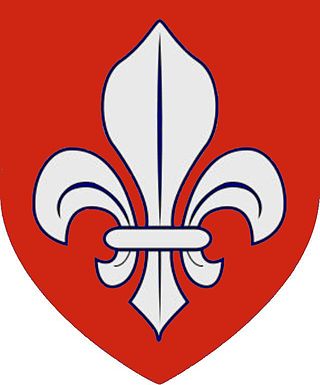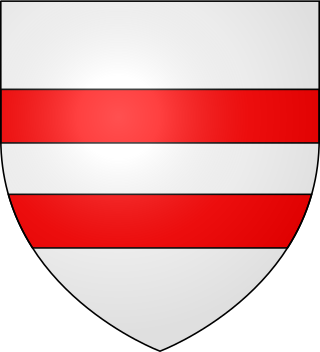
Ralph Neville, 1st Earl of WestmorlandEarl Marshal, was an English nobleman of the House of Neville.

William de Valence, born Guillaume de Lusignan, was a French nobleman and knight who became important in English politics due to his relationship to King Henry III of England. He was heavily involved in the Second Barons' War, supporting the king and Prince Edward against the rebels led by Simon de Montfort. He took the name de Valence after his birthplace, the Cistercian abbey of Valence, near Lusignan in Poitou.
Peter de Montfort of Beaudesert Castle was an English magnate, soldier and diplomat. He is the first person recorded as having presided over Parliament as a parlour or prolocutor, an office now known as Speaker of the House of Commons. He was one of those elected by the barons to represent them during the constitutional crisis with Henry III in 1258. He was later a leading supporter of Simon de Montfort, 6th Earl of Leicester against the King. Both he and Simon de Montfort were slain at the Battle of Evesham on 4 August 1265.

Thomas West, 1st Baron West was an English nobleman and member of parliament.

William de Redvers, 5th Earl of Devon, of Tiverton Castle and Plympton Castle, both in Devon, was feudal baron of Plympton in Devon.
Joan Holland was the third daughter of Thomas Holland, 2nd Earl of Kent, and Alice FitzAlan. She married four times. Her first husband was a duke, and the following three were barons. All of her marriages were most likely childless.

Robert FitzWalter, 1st Baron FitzWalter was an English landowner, soldier, administrator and politician.
Joan de Geneville, 2nd Baroness Geneville, Countess of March, Baroness Mortimer, also known as Jeanne de Joinville, was the daughter of Sir Piers de Geneville and Joan of Lusignan. She inherited the estates of her grandparents, Geoffrey de Geneville, 1st Baron Geneville, and Maud de Lacy, Baroness Geneville. She was one of the wealthiest heiresses in the Welsh Marches and County Meath, Ireland. She was the wife of Roger Mortimer, 1st Earl of March, the de facto ruler of England from 1327 to 1330. She succeeded as suo jure 2nd Baroness Geneville on 21 October 1314 upon the death of her grandfather, Geoffrey de Geneville.

William Brewer of Tor Brewer in Devon, was a prominent administrator and judge in England during the reigns of kings Richard I, his brother King John, and John's son Henry III. He was a major landholder and the founder of several religious institutions. In 1204, he acquired the feudal barony of Horsley in Derbyshire.
Alice de Warenne, Countess of Arundel was an English noblewoman and heir apparent to the Earldom of Surrey. In 1305, she married Edmund FitzAlan, 2nd Earl of Arundel.
Reginald de Warenne was an Anglo-Norman nobleman and royal official. The third son of an earl, Reginald began his career as an administrator of his brother's estates, and continued to manage them for his brother's successor, William, the second son of King Stephen. Reginald was involved in the process that led to the peaceful ascension of Henry fitzEmpress to the throne of England in 1154 and served the new king as a royal justice afterwards. He played a minor role in the Becket controversy in 1170, as a member of the party that met Becket on his return to England from exile in 1170.
Robert fitzRoger was an Anglo-Norman nobleman and Sheriff of Norfolk and Suffolk and Northumberland. He was a son of Roger fitzRichard and Adelisa de Vere. FitzRoger owed some of his early offices to William Longchamp, but continued in royal service even after the fall of Longchamp. His marriage to an heiress brought him more lands, which were extensive enough for him to be ranked as a baron. FitzRoger founded Langley Abbey in Norfolk in 1195.
William de Warenne was the only son of John de Warenne, 6th Earl of Surrey and his wife Alice de Lusignan.

The Aguillon family, of French origin, were feudal landowners in England who held estates in several southern counties from before 1135 to 1312. Surviving records suggest various branches which all ended without male heirs, the lands going to daughters or sisters and their husbands. The family seems to have been initially associated, perhaps as under-tenants and maybe through marriage, with the Marmion family, witnessing charters alongside them in Normandy in 1106 and later occupying their land in England.

Peter FitzHerbert, also known as Piers FitzHerbert, Lord of Blenlevenny, was a 13th-century nobleman and Sheriff of Yorkshire. FitzHerbert was one of the Counsellors named in Magna Carta in 1215. He was the son of Herbert FitzHerbert and Lucy of Hereford.

John FitzReginald, also known as John FitzReynold, Lord of Blenlevenny was an English noble. He was a signatory of the Barons' Letter of 1301.
Reginald FitzReginald, also known as Reynold FitzReynold, Lord of Hinton Martell, was an English noble.
Peter FitzReginald, also known as Piers FitzReynold, Lord of Chewton was an English noble.
Matthew FitzHerbert, Lord of Erlestoke and Stokenham, was an English nobleman and Sheriff of Sussex. FitzHerbert was one of the Counsellors named in Magna Carta in 1215. He was the son of Herbert FitzHerbert and Lucy de Hereford. His elder brother was Peter FitzHerbert.

William Martin, 1st Baron Martin , Lord of Cemais and Barnstaple was an English noble. He fought in the wars in Wales, Gascony, Flanders and Scotland. He was a signatory of the Baron's Letter to Pope Boniface VIII in 1301.









